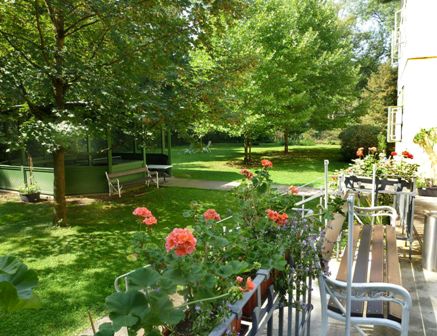Natural areas in hospitals promote healing
16 July 2012
The design and landscaping of hospital green areas in accordance with the needs of patients, staff and doctors can have a health-promoting effect, according to a study by the Medical University of Vienna.
This result echoes the findings of earlier studies, such as the 1984 study by Roger Ulrich who discovered that a view from the hospital room overlooking green spaces has more of a “healing” effect than a view of a concrete wall. Patients with a view of green space spent less time in the hospital, were generally more happy with their care and required less pain-relieving medication.
Counterbalance to hospital environment
“The gardens and green spaces of a hospital should be regarded as a counterbalance to the hospital itself,” explains the environmental and health psychologist Renata Cervinka from the Institute for Environmental Hygiene at the Centre for Public Health at the University. “The garden is perceived as a natural contrast to the hospital — it serves as a place of sanctuary and recuperation."
The study found that green, very natural landscaped gardens came closest to the ideal hospital garden imagined by the 411 potential patients who were surveyed anonymously on the web.
Just three minutes in the garden can have positive effects
“Deep breathing in a green space for just three minutes can have a
positive effect,” says study co-author Kathrin Rödere. “The smoking
break is firmly entrenched in modern life, however the 'mental'
break isn't, unfortunately.”
This break has even more impact the more the gardens and places of sanctuary are tailored to the needs of their users. “At a general hospital, for example, where patients do not stay for very long, even a view of the appropriately-landscaped green space can have a health-promoting effect. For other groups, such as patients undergoing orthopaedic rehabilitation, it is more important that the gardens can also be enjoyed while using walking aids, for example. Long-term patients, such as geriatric or psychiatric patients, particularly benefit from activities involving gardening.” The authors also recommend separate green areas for hospital personnel that are private from the patients.

A natural area in a hospital
Importance of old trees
“The proven therapeutic effect should also counteract the trend towards regarding green spaces as purely places of rest or potential building plots,” says Cervinka. “The value of nature is incalculable. Its worth is priceless.” With this in mind, the study authors also point out how crucial it is to preserve large, old trees when carrying out extensions and conversions: “Trees have a very important role to play in recovering from stress and in mental health. They are easily felled, however they take a long time to grow.”
On the basis of the study findings, a checklist has been developed that can be used to create the ideal design for hospital gardens — with the aim of lifting the mood of their users, promoting their wellbeing and increasing the gardens’ proximity to nature.
More information
1. Cervinka R, Röderer K, Hämmerle I, & Hemmelmeier-Händel B. From open and green space at hospitals to healing gardens? Transdisciplinary assessment and recommendations for (re)design. Case study presented at the 22nd IAPS Conference, June 25-29, 2012. Glasgow, UK.